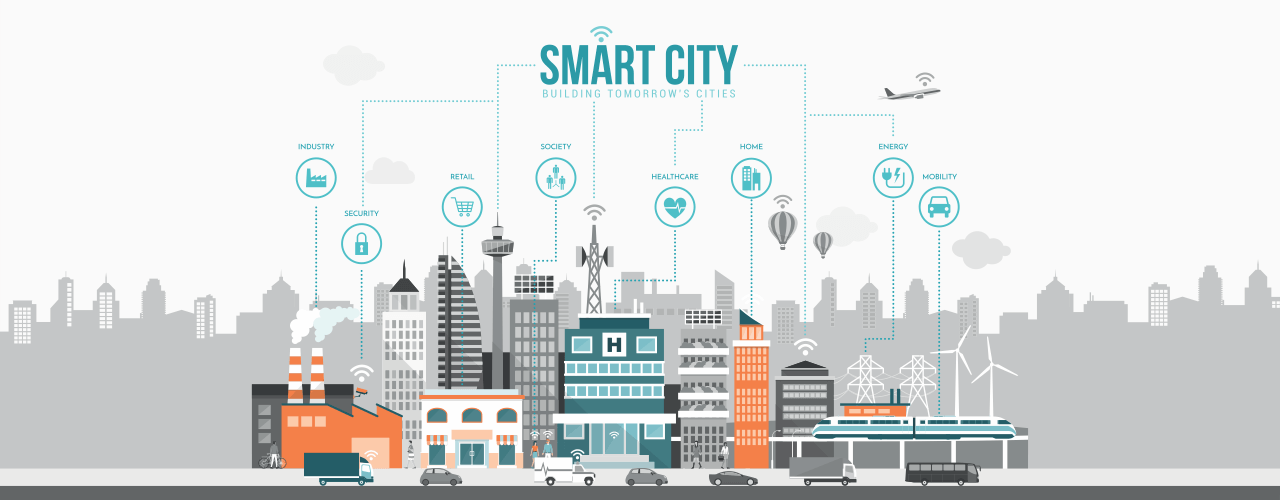Smart cities are cities that incorporate the internet of things throughout the urban structure with smart technologies, to improve quality of life and business.
Information and communication technologies – or ICT – are used to boost the quality and performance of municipal services such as energy, transportation, and utilities while reducing consumption, waste, and costs. This, in turn, improves the quality of life for residents and allows businesses to run efficiently, profitably, and with a social conscience.
5 Framework Factors That Make A City ‘Smart’
The definition of a smart city continues to evolve as new technologies come to market and current technologies grow. Active participation by citizens of the city plays a key role in determining which technologies best serve individual communities.
A wide variety of ICT services can be used to improve working environments, make government systems run more efficiently, and foster community innovation and knowledge sharing by bringing people closer together.
There are five frameworks used to weave information and communication technologies throughout the urban environment:
Technology
There are several technological concepts within the technology framework that can be combined to build smart cities:
- Digital cities provide community connectivity via broadband, flexible service-oriented computing infrastructure, and innovative services to meet the needs of government, citizens, and businesses.
- Information that cities collect safely and securely to link city services, interaction amongst the community, and between government institutions.
- Intelligent cities incorporate and maintain the latest in telecommunications, electronic, and mechanical technologies to support learning, knowledge sharing, and creativity.
- Ubiquitous cities allow citizens and business to connect to services anywhere, any place, and any time through any device.
- Cognitive cities merge the internet of things and smart technologies with artificial intelligence to continuously learn from the big data the urban environment generates.
Human
Smart cities should also be developed around the wants and needs of the people they serve:
- Creative cities use intellectual and social capital to build a city that is smart,
- Learning cities focus on building a skilled workforce,
- Humane cities leverage the existing knowledge of the workforce,
- Knowledge cities focus on innovation.
Institutional
In the institutional framework, citizens partner with government and public-private institutions to promote the use of information technologies to improve the quality of life and reinvent the city to meet the needs of a changing economy.
Energy
Utility companies play a key role in the energy framework of smart cities. The internet of things is used to better manage energy assets and smart connections in services such as street lighting, buildings, smart transportation, distributed energy resources, and big data analytics.
Data Management
Data from the entire urban environment is collected, processed, and shared to improve the overall quality of life for residents and business. Data sources include information from utilities, health organizations, transportation systems, entertainment, and government services.
Commercial Real Estate And Smart Cities
Large internet technology and energy management companies such as Cisco and IBM, Microsoft and Google, all actively participate in smart city initiatives to stimulate economic growth and improve the quality of life for residents and business in the communities that they serve.
The Knight Frank 1st Edition Your Space Report noted how smart technologies within major office markets in the U.S. and around the world are acting as both disruptors of current business models and as key drivers for office leasing activity within markets such as Austin and Seattle that are home to tech and creative talent. Occupiers of office space are increasingly locating in smart cities that are home to a skilled workforce and smart infrastructure.
Six key factors that drive the commercial real estate market in smart cities are:
- Educational infrastructure,
- Technology talent,
- Economy supporting tech and start-up businesses,
- Technology-based smart growth initiatives,
- Capacity of a city to innovate,
- Infrastructure that allows the city to become smart.
4 Of America’s Smartest Cities
Office space is increasingly being viewed by space occupiers as a flexible service rather than a fixed asset. That’s one of the key reasons why coworking office space companies such as WeWork and Knotel have become the biggest operators of office space in hyper-competitive office markets such as Manhattan and San Francisco.
In a similar way that office space is being viewed as a service, cities themselves are also being viewed as a service by both residents and the business community. As labor, knowledge, and investment capital become more mobile, cities that serve the community via smart technologies are poised for long-term growth and development.
Four of the many cities in America actively pursuing a smart city strategy are:
- Columbus, which is expanding the electric infrastructure by converting public vehicle fleets to electric cars, creating new electric vehicle charging stations, and providing incentives for ride-share commuting.
- New York City focuses on mixed-use and transit-oriented development initiatives such as the High Line project on the Lower West Side of Manhattan and Hudson Square to take advantage of existing transit infrastructure and business density.
- San Francisco has one of the highest-densities of LEED-certified buildings in the U.S. and is near the high-tech Silicon Valley cities of Palo Alto, Mountain View, and San Jose.
- San Leandro, CA is partnering with utility company PG&E and transforming itself from an industrial center to a technology hub with new commercial office developments such as the San Leandro Tech Campus.













